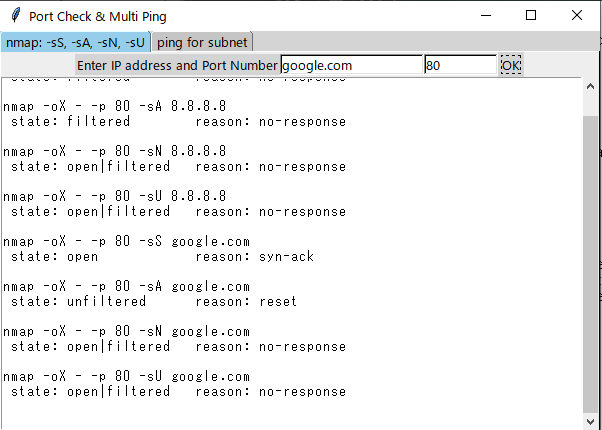ポートOpen/Close確認やマルチpingの実行
pythonのnmapモジュールおよびICMPLibを使って、ポートOpen/Closeなどの確認やマルチpingの実行を、tkinterによりGUIプログラム化する。
ポートOpen/Closeなどの確認
ある特定のIPアドレスおよびポート番号にて、nmapのいくつかのオプション結果を同時に確認したかった(あまりそのようなものを見たことがなかった)ので、作ってみることにした。下記スキャンの結果を同時に表示する。
- -sS:TCP Synスキャン
- -sA:TCP Ackスキャン
- -sN:TCP Nullスキャン
- -sU:UDPスキャン
同一サブネット内のIPアドレス複数にping
例えば、「192.168.1.42/29」の場合、下記のIPアドレスにpingを行い、リプライがあったIPアドレスを表示する。
- 192.168.1.41
- 192.168.1.42
- 192.168.1.43
- 192.168.1.44
- 192.168.1.45
- 192.168.1.46
実行結果例
nmap
マルチping
ソースコード
nmap
import nmap
def ExecNmap(ip, num, arg, out):
nm = nmap.PortScanner()
scan_result = nm.scan(hosts = ip, ports = num, arguments = arg)
out = out + nm.command_line() + '\n'
#print(scan_result['scan'])
target = next(iter(scan_result['scan'])) # for domain name ('ip' cannot be used.)
if arg == '-sU':
detail = scan_result['scan'][target]['udp']
else:
detail = scan_result['scan'][target]['tcp']
first = next(iter(detail)) # 'num' does not work
out = out + ' state: ' + detail[first]['state'] \
+ '\t\t\treason: ' + detail[first]['reason'] + '\n\n'
return out
- out:結果を格納するバッファ
- nm.scan():nmap実行
- nm.command_line():コマンドラインをバッファに格納
- scan_result['scan']:nmap実行結果(下記はサンプル)
{'74.6.143.26': {'hostnames': [{'name': 'yahoo.com', 'type': 'user'}, {'name': 'media-router-fp74.prod.media.vip.bf1.yahoo.com', 'type': 'PTR'}], 'addresses': {'ipv4': '74.6.143.26'}, 'vendor': {}, 'status': {'state': 'up', 'reason': 'echo-reply'}, 'tcp': {80: {'state': 'open', 'reason': 'syn-ack', 'name': 'http', 'product': '', 'version': '', 'extrainfo': '', 'conf': '3', 'cpe': ''}}}} - target = next(iter(scan_result['scan'])):結果の最初の要素であるIPアドレスを取得(対象IPアドレスをドメイン名で指定したときにも対応するため)
- TCPスキャンかUDPスキャンかで取得の仕方を変える
- first = next(iter(detail)):ポート番号を文字列化
- 「state」および「reason」の結果をバッファに格納
multiPing
from netaddr import *
from icmplib import *
def ExecPing(arg):
ipNet = IPNetwork(arg)
ipList=list(ipNet)
Len = len(ipList)
target = []
for ip in ipList[1:Len-1]:
target.append(str(ip))
hosts = multiping(target, count=3)
return hosts
- netaddr(IPNetwork())により同一サブネット内のIPアドレス群を取得
- 最初(ネットワークアドレス)および最後(ブロードキャストアドレス)を除いたIPアドレスのリスト化(target)
- マルチping実行
OKボタンクリック
def ok_clk(frm, arg):
ip = frm.entry1.get()
if arg == 0:
num = frm.entry2.get()
out = ''
out = ExecNmap(ip, num, '-sS', out)
out = ExecNmap(ip, num, '-sA', out)
out = ExecNmap(ip, num, '-sN', out)
out = ExecNmap(ip, num, '-sU', out)
else:
hosts = ExecPing(ip)
out = 'ping to ' + ip + '\n'
for host in hosts:
if host.is_alive:
out = out + ' ' + host.address + '\tis up' + '\n'
frm.text.config(state='normal') # editable
frm.text.insert(tk.END, out)
frm.text.config(state='disabled') # not editable
frm.text.see('end')
return
- Entryボックスに入力された内容の取得
- nmap実行関数またはマルチping実行関数の呼び出し
- マルチpingの場合は、結果の加工
- テキストボックスへ結果をアウトプット
タブ作成
def create_content(frm, arg):
frm1 = tk.Frame(frm)
frm2 = tk.Frame(frm)
frm1.pack()
frm2.pack()
frm.entry1 = ttk.Entry(frm1, width=20)
frm.entry1.grid(row=0, column=1)
if arg == 0:
label = ttk.Label(frm1, text='Enter IP address and Port Number')
frm.entry2 = ttk.Entry(frm1, width=10)
frm.entry2.grid(row=0, column=2)
else:
label = ttk.Label(frm1, text='Enter Network (ex 192.168.1.0/24)')
label.grid(row=0, column=0)
okBtn = ttk.Button(frm1, text='OK', command=lambda:ok_clk(frm, arg))
okBtn.grid(row=0, column=3)
frm.text = tk.Text(frm2, width=80, height=40)
ysc = tk.Scrollbar(frm2, orient=tk.VERTICAL, command=frm.text.yview)
frm.text["yscrollcommand"] = ysc.set
ysc.pack(side=tk.RIGHT, fill="y")
frm.text.config(state='disabled') # not editable
frm.text.pack()
return
ここは、その5あたりを参照されたし。
メインプログラム
# root main window
root = tk.Tk()
root.title("Port Check & Multi Ping")
root.geometry("600x400")
# Create an instance of ttk style
fgcolor = "lightskyblue2"
bgcolor = "gray80"
style = ttk.Style()
style.theme_create("style1", parent="alt", settings={
"TNotebook.Tab": {
"configure": {"background": bgcolor },
"map": {"background": [("selected", fgcolor)],
} } } )
style.theme_use("style1")
# Create Notebook Widget
note = ttk.Notebook(root)
# Create tab
tab0 = tk.Frame(note)
tab1 = tk.Frame(note)
# Add tab
note.add(tab0, text=tab_list[0])
note.add(tab1, text=tab_list[1])
# Create content of tab
create_content(tab0, 0)
create_content(tab1, 1)
# Locate tab
note.pack(expand=True, fill='both')
# main loop
root.mainloop()
ここも、その5を参照されたし。
全体
import nmap
from netaddr import *
from icmplib import *
import tkinter as tk
import tkinter.ttk as ttk
# command to execute
tab_list = [' nmap: -sS, -sA, -sN, -sU ', ' ping for subnet ']
# execute nmap
def ExecNmap(ip, num, arg, out):
nm = nmap.PortScanner()
scan_result = nm.scan(hosts = ip, ports = num, arguments = arg)
out = out + nm.command_line() + '\n'
#print(scan_result['scan'])
target = next(iter(scan_result['scan'])) # for domain name ('ip' cannot be used.)
if arg == '-sU':
detail = scan_result['scan'][target]['udp']
else:
detail = scan_result['scan'][target]['tcp']
first = next(iter(detail)) # 'num' does not work
out = out + ' state: ' + detail[first]['state'] \
+ '\t\t\treason: ' + detail[first]['reason'] + '\n\n'
return out
# execute multi-ping
def ExecPing(arg):
ipNet = IPNetwork(arg)
ipList=list(ipNet)
Len = len(ipList)
target = []
for ip in ipList[1:Len-1]:
target.append(str(ip))
hosts = multiping(target, count=3)
return hosts
# Function for click OK
def ok_clk(frm, arg):
ip = frm.entry1.get()
if arg == 0:
num = frm.entry2.get()
out = ''
out = ExecNmap(ip, num, '-sS', out)
out = ExecNmap(ip, num, '-sA', out)
out = ExecNmap(ip, num, '-sN', out)
out = ExecNmap(ip, num, '-sU', out)
else:
hosts = ExecPing(ip)
out = 'ping to ' + ip + '\n'
for host in hosts:
if host.is_alive:
out = out + ' ' + host.address + '\tis up' + '\n'
frm.text.config(state='normal') # editable
frm.text.insert(tk.END, out)
frm.text.config(state='disabled') # not editable
frm.text.see('end')
return
# Create content of tab
def create_content(frm, arg):
frm1 = tk.Frame(frm)
frm2 = tk.Frame(frm)
frm1.pack()
frm2.pack()
frm.entry1 = ttk.Entry(frm1, width=20)
frm.entry1.grid(row=0, column=1)
if arg == 0:
label = ttk.Label(frm1, text='Enter IP address and Port Number')
frm.entry2 = ttk.Entry(frm1, width=10)
frm.entry2.grid(row=0, column=2)
else:
label = ttk.Label(frm1, text='Enter Network (ex 192.168.1.0/24)')
label.grid(row=0, column=0)
okBtn = ttk.Button(frm1, text='OK', command=lambda:ok_clk(frm, arg))
okBtn.grid(row=0, column=3)
frm.text = tk.Text(frm2, width=80, height=40)
ysc = tk.Scrollbar(frm2, orient=tk.VERTICAL, command=frm.text.yview)
frm.text["yscrollcommand"] = ysc.set
ysc.pack(side=tk.RIGHT, fill="y")
frm.text.config(state='disabled') # not editable
frm.text.pack()
return
# Start of main program
# root main window
root = tk.Tk()
root.title("Port Check & Multi Ping")
root.geometry("600x400")
# Create an instance of ttk style
fgcolor = "lightskyblue2"
bgcolor = "gray80"
style = ttk.Style()
style.theme_create("style1", parent="alt", settings={
"TNotebook.Tab": {
"configure": {"background": bgcolor },
"map": {"background": [("selected", fgcolor)],
} } } )
style.theme_use("style1")
# Create Notebook Widget
note = ttk.Notebook(root)
# Create tab
tab0 = tk.Frame(note)
tab1 = tk.Frame(note)
# Add tab
note.add(tab0, text=tab_list[0])
note.add(tab1, text=tab_list[1])
# Create content of tab
create_content(tab0, 0)
create_content(tab1, 1)
# Locate tab
note.pack(expand=True, fill='both')
# main loop
root.mainloop()
EOF

